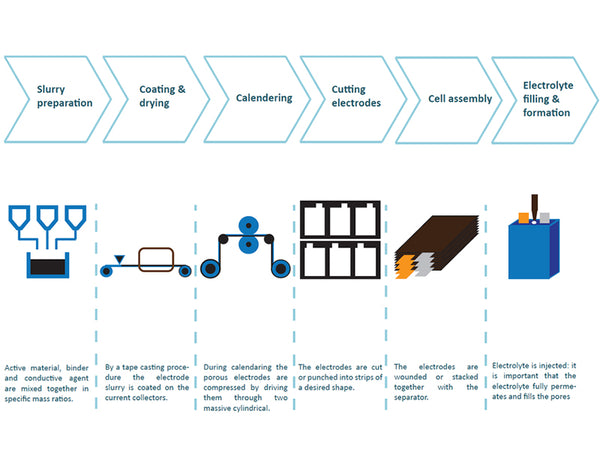
The structure of the battery, the casing and parts, the external dimensions and manufacturing process of the electrode, the ratio of the bipolar materials, and the tightness of the battery assembly all have different degrees of influence on the performance of the battery. Therefore, reasonable battery design and optimized production process are the keys to the accuracy, reproducibility, and reliability of the research results.
 Lithium-ion battery manufacturing steps
Lithium-ion battery manufacturing steps
As a kind of chemical power source, the design of lithium ion battery also needs to be suitable for the basic ideas and principles of chemical power source.
A chemical power source is a device that directly converts chemical energy into low-voltage DC electrical energy. This device is actually a small DC generator or energy converter. According to the technical requirements of electrical appliances, the corresponding chemical power supply also has corresponding technical requirements. Manufacturers all try to make the chemical power supply not only can play its own characteristics, but also can meet the requirements of the whole machine with better performance. The process in which this design idea and principle enables the chemical power supply to meet the technical requirements of the whole machine is called the design of the chemical power supply.
The design of chemical power supply mainly solves the problems:
① Design the structure and process within the allowable size and weight range to meet the power requirements of the complete system;
②Find a feasible and simple and feasible process route;
③ Minimize battery cost;
④If conditions permit, improve the technical performance of the product;
⑤The greatest possible realization of green energy, overcoming and solving environmental pollution problems.
With the commercialization of lithium-ion batteries, more and more fields use lithium-ion batteries. Due to technical problems, the current lithium-ion batteries still use lithium cobalt oxide as their cathode material. Cobalt is a strategic resource and its price is quite expensive. At the same time, due to its high toxicity, there is an environmental pollution problem. Efforts in this area are ongoing. Fortunately, lithium manganese oxide and its doped compounds are becoming the most challenging alternative to lithium cobalt oxide as cathode materials that have attracted more and more attention and will be available.
The traditional calculation method of battery design is to select and calculate according to the required conditions based on the accumulated experience or experiment in the design of the chemical power supply, and to determine the reasonable parameters after further experiments. In addition, with the development and application of electronic computer technology, it has also opened up the way for battery design. It is now possible to compile computer programs for design based on past experience data. It is expected that the future will be further developed to completely use computers for design, which has broad prospects for shortening the development cycle of batteries.
The design of the battery includes performance design and structural design. The so-called performance design refers to the design of voltage, capacity and life. The structural design refers to the design of the battery case, diaphragm, electrolyte and other structural parts.
 General procedure for lithium-ion battery design
General procedure for lithium-ion battery design
The general procedure of design is divided into the following three steps.
The first step: Comprehensive analysis of various given technical indicators to find out the key issues.
Usually in order to meet the technical requirements of the complete machine, the proposed technical indicators include working voltage, voltage accuracy, working current, working time, mechanical load, life and ambient temperature, etc. The main ones are working voltage (and voltage accuracy), capacity and life. .
The second step: Perform performance design. According to the key issues to be solved, on the basis of the accumulated test data and the experience accumulated in the actual production, determine the appropriate working current density, select the appropriate process type, in order to make a reasonable voltage and other performance design. According to the actual required capacity, determine the appropriate design capacity to determine the proportional dosage of the active material. Choose the appropriate diaphragm material, shell material, etc. to determine the life design. When selecting materials, new materials should be selected as far as possible based on battery requirements while ensuring the cost. Of course, when these designs are all related, comprehensive consideration should be given to them, and no one aspect should be neglected.
The third step: Carry out structural design. Including the determination of the external dimensions, the housing design of the single battery, the design of the electrolyte, the design of the diaphragm, and the design of conductive nets, poles, and pores. For the battery pack, the battery pack, battery pack casing, lining material, and heating system are also designed.
The design should focus on the main issues, compromise and balance the secondary issues, and finally determine a reasonable design plan.